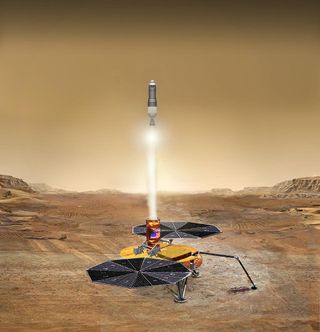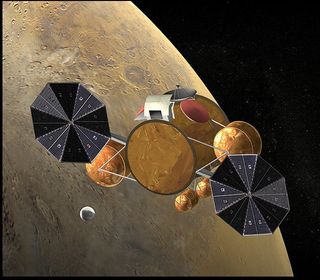
Over the next few months, NASA will map out a strategy for returning bits of Martian rock and soil to Earth, so scientists can study them for signs of past Red Planet life.
That ambitious goal should drive the space agency's next steps at Mars, according to a report released Tuesday (Sept. 25) by the Mars Program Planning Group. The report also lays out several ways Mars sample-return can be accomplished over the next decade or two, and NASA is reviewing those options now.
The agency may reveal its chosen path in February, after the White House releases its federal budget request for fiscal year 2014, NASA officials said Tuesday. In the meantime, here's a brief rundown of the scenarios they're looking at.
Multiple launches
All the major options proposed by the Mars planning group share three basic components in common: a sampling rover, a Mars Ascent Vehicle (MAV) for blasting the collected rock and soil off the Red Planet surface and a return orbiter, which will snag the samples in space and ferry them to Earth's neighborhood.
In one scenario, these three pieces are all launched separately, with a small "fetch" rover riding along with the MAV. As its name suggests, the fetch rover will carry Red Planet dirt from the sampling rover back to the MAV. [7 Biggest Mysteries of Mars]
This strategy has the advantage of spreading costs and technical challenges across three missions — which could each be at least two years apart, since Mars launch windows come about every 26 months — according to the planning group report.
Get the Space.com Newsletter
Breaking space news, the latest updates on rocket launches, skywatching events and more!
Another option is to consolidate into two launches. The sampling rover would ride alone, while another liftoff would carry the MAV, fetch rover and return orbiter.
In this case, the orbiter would likely have to be powered by solar electic propulsion (SEP), to cut down on weight. The amount of liquid propellant needed for a traditionally powered spacecraft would be quite heavy.

A single launch
Alternatively, all the pieces needed for Mars sample-return could be lofted in a single shot, the report says.
In this case, the sampling rover would carry an integrated MAV with it, eliminating the need for a fetch rover. Again, the return orbiter would be an SEP craft, which creates thrust by accelerating electrically charged atoms or molecules.
The single-launch option would eliminate some mission complexities, such as coordinating the meetup of samples with the MAV. And it would reduce the project's overall cost by cutting out a launch or two. But this scenario has the highest peak-year costs, the report states.
"They all have their pluses and minuses," Orlando Figueroa, team leader of the Mars Program Planning Group, said of the 1-, 2- and 3-launch options.
"It gives you multiple ways to look at this problem, consistent with budget concerns, consistent with opportunities for collaboration, more technology, et cetera," Figueroa told reporters Tuesday. "And that's what we tried to do — bring all of those options forth to NASA for consideration."
Multiple rovers?
The above options assume that NASA will pick suitable sampling sites using existing data. But the MPPG report also outlines a path that allows for more on-the-ground research, which some scientists may feel is warranted for such an ambitious and expensive project.
"Preservation of biological signatures is rare on Earth, and investigations at multiple sites on Mars dramatically improves the probability of identifying biologically relevant samples," the report states. [5 Bold Claims of Alien Life]
If NASA chooses this course, multiple rovers would be sent to investigate several different sites. Based on the rovers' findings, scientists would eventually select one site for sample return. Mars material would be delivered to Earth via an MAV and return orbiter, as discussed above.
Multiple rovers would incur greater costs, but building identical robots off a production line could help keep the price tag down, the report says.

The human touch
In 2010, President Barack Obama charged NASA with getting astronauts to the vicinity of Mars by the mid-2030s.
The space agency thinks this goal dovetails nicely with its sample-return ambitions, and it sees plenty of room for collaboration between its robotic and human exploration programs in this arena.
For example, astronauts aboard NASA's Orion capsule — which is still under development — might be dispatched to intercept the return orbiter in deep space and bring the Mars samples down to Earth, officials said Tuesday.
This approach would eliminate the need to harden the sample capsule for Earth entry, since it would land aboard Orion. And an astronaut inspection would also help ensure the Mars sample is adequately contained, officials said.
"It is taking advantage of the human architecture, because we anticipate it will be there," said John Grunsfeld, associate administrator for NASA’s Science Mission Directorate.
"And it potentially solves an issue of, when we return samples, somewhere we have to make sure that the samples are completely contained so there's no chance — remote as it may be — that there is something on Mars that could contaminate Earth," he added.
NASA is hoping to launch its first piece of the Mars sample-return architecture in 2018 or 2020, Grunsfeld said. The agency has just $800 million or so to work with until then — too little for a rover, so NASA will likely launch an orbiter if it chooses the 2018 opportunity, Figueroa said.
But just when pristine little pieces of the Red Planet could make their way to Earth — and into scientists' labs — remains very much up in the air.
"As far as time frame — that's all forward work, to figure out," Grunsfeld said.
Follow SPACE.com senior writer Mike Wall on Twitter @michaeldwall or SPACE.com @Spacedotcom. We're also on Facebook and Google+.
Join our Space Forums to keep talking space on the latest missions, night sky and more! And if you have a news tip, correction or comment, let us know at: community@space.com.

Michael Wall is a Senior Space Writer with Space.com and joined the team in 2010. He primarily covers exoplanets, spaceflight and military space, but has been known to dabble in the space art beat. His book about the search for alien life, "Out There," was published on Nov. 13, 2018. Before becoming a science writer, Michael worked as a herpetologist and wildlife biologist. He has a Ph.D. in evolutionary biology from the University of Sydney, Australia, a bachelor's degree from the University of Arizona, and a graduate certificate in science writing from the University of California, Santa Cruz. To find out what his latest project is, you can follow Michael on Twitter.
